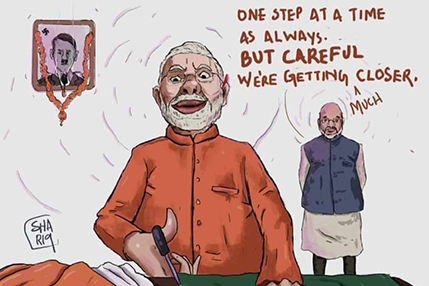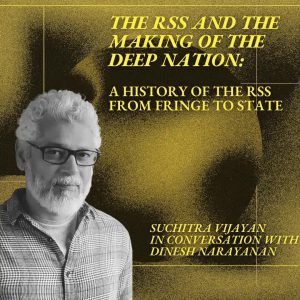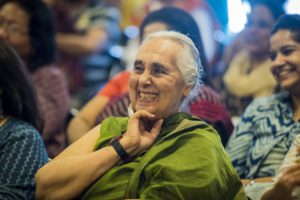
- Conversations
India’s breaking point, a talk by Prof Alf Gunvald Nilsen


As everyone here is probably aware, for staff and students at Jawaharlal Nehru University – one of India’s premier institutions of research and higher learning – 2020 began in the most harrowing way. In the early evening of January 5, approximately 50 people, heavily armed and many of them masked, made their way on to campus and launched a three-hour-long violent attack that deliberately targeted students and academics who were thought to be participants involved in the protest against fee hikes that has been going on at the university for the past few months. Some thirty students and several faculty members were injured during the violence. Delhi police stood idly by while the attack took place. In its aftermath, they allowed the attackers – many of whom have been identified as members of the Akhil Bharatiya Vidyarthi Parishad (ABVP), the student wing of the Rashtriya Swayamsevak Sangh (RSS), which is the central node in the vast organizational network of the Hindu nationalist movement – to freely make their way off-campus. Not a single arrest was made on the evening of January 5, and this remains the case at the time of writing, three days after the attack.
However, in the kind of mockery of justice that has become only too common under the reign of Narendra Modi and the right-wing Bharatiya Janata Party (BJP), police authorities have filed incident reports against Aishe Ghosh, the JNU Student Union leader who was gravely injured in the attack, and nineteen other student activists. This has been done on the basis of allegations made by JNU management – a management that is widely known to be a partisan of the political project of the Modi regime – that they were involved in vandalism on the university campus prior to the attack last Sunday. It is quite telling that these incident reports were lodged while the mob assault on JNU was ongoing – that is, it is telling of the integrity of the incident reports and of the purpose that they are intended to serve.
The attacks on students and faculty at JNU can be read in terms of ongoing conflict at a single university, but it is equally important to consider its significance in relation to the protests that have been ongoing across India since the middle of December, against the introduction of citizenship laws that are widely – and correctly – perceived to be both anti-Muslim and a threat to the secular fabric of the Indian Constitution. Indeed, the attack fits a disturbing pattern that has emerged over the past few turbulent weeks, in which universities have been subjected to severe and violent repression. In the cases of Jamia Millia Islamia University in Delhi and Aligarh Muslim University in the BJP-ruled state of Uttar Pradesh, it is of course highly significant that it is the police have meted out this repression, which have left students seriously injured and maimed.
The protests, as many of you will be aware of, are directed against the Citizenship Amendment Act (CAA) – a law that was passed by the Indian parliament on December 11, which makes it possible for specific religious minorities from Afghanistan, Pakistan, and Bangladesh to obtain Indian citizenship – and the imminent implementation of a National Registry of Citizens. I will have more to say about this legislation very shortly, but it is necessary to note, first of all, that the protests that we have been witnessing – protests which have been energized in no small part by the collective action of Muslims, who are particularly vulnerable citizens in Modi’s India – constitute the first serious national-level hurdle in the onward march of the BJP regime since it first came to power in 2014.
It’s also, I think, necessary to note just how brutally the regime has responded to these protests. At the time of writing, 31 people have been killed. Most of these killings have occurred in the BJP-ruled state of Uttar Pradesh, where police have unleashed a reign of terror against Muslims and Muslim communities in order to discourage protests. “What we are witnessing in Chief Minister Yogi Adityanath’s Uttar Pradesh,” said veteran civil society activist Harsh Mander, “is the police force itself becoming the riotous lynch mob.” Across the nation, thousands of protesters have been detained or arrested, and large numbers have suffered violent beatings at the hands of the police. Protests have been banned in BJP-ruled states, and authorities have shut down the internet and telephone networks. Despite all these vulgar displays of state power, protests continue.

Let us, then, be very, very clear: this clash between citizens using their constitutional right to protest and a government whose entire playbook is defined by majoritarian cultural nationalism and violent coercion is nothing short of a breaking point for Indian democracy. And it is crucial that we understand that it is a breaking point that has been in the making since Modi and the BJP assumed power in India in 2014. I hope what I have to say here today makes some kind of small contribution towards this end.
I’m going to start with the most immediate question: why has the CAA, which was passed into law on 11 December, met with so much anger and opposition in India’s public sphere? “It’s a humanitarian issue, beyond political ideologies,” said Amit Shah, India’s Home Minister, when the legislation was being debated in the Indian parliament. On the face of it, this is true – the CAA offers expedited citizenship for persecuted religious groups from Afghanistan, Pakistan, and Bangladesh who can prove that they have been living in India since before 31 December 2014. However, there is a catch – and that catch is religiously defined: the CAA only extends this right to Hindus, Christians, Sikhs, Buddhists, Jains, and Parsis. Muslims – for example Afghan Hazaras, Pakistani Ahmadiyya Muslims, and Rohingyas from Myanmar – are excluded from its remit.
This omission, of course, testifies to how the CAA is intended to advance the Hindu nationalist ideology that is so central to the political project of Modi and the BJP. At the core of this ideology lies the belief that India should be a nation for and of Hindus – the so-called Hindu Rashtra. According to its key tenets, India’s Muslim community – a minority of some 200 million, or approximately 14% of India’s 1.3 billion-strong population – constitutes a threat to the integrity of the Hindu nation, and this threat must be flushed out and defeated. “The worry,” argues Professor Niraja Gopal Jayal, a preeminent scholar of the Indian constitution, “is that the introduction of the religious criterion will yield, effectively, a hierarchy of citizens, a kind of two-tiered, graded citizenship.” And it is abundantly clear that Indian Muslims will end up as second-class citizens in this hierarchy.
This is due to the fact that the BJP aims to couple the CAA with the introduction of a national population register and a National Registry of Citizens (NRC). Under the provisions of the NRC, the right to Indian citizenship is directly linked to whether or not individuals can prove that they were born in India between January 1950 and June 1987, or that they are children of bona fide Indian citizens. In a country where it is more common than not that people – especially poor people, of which there are many in India – do not have the kind of documents required by this process, many risk losing their citizenship. However, Hindus who find themselves in this situation can make use of the lifeline offered by the CAA.
The fact that this opportunity is not afforded to Muslims results in an excruciating vulnerability, which again is the result of an explicit design. “First, we will bring Citizenship Amendment Bill and will give citizenship to the Hindu, Buddhist, Sikh, Jain and Christian refugees, the religious minorities from the neighbouring nations,” Amit Shah declared in one of his many speeches during the campaign for the 2019 general election. “Then,” he continued, ”we will implement NRC to flush out the infiltrators from our country.” With “infiltrators” being staple Hindu nationalist dogwhistle-speak for Muslims, the writing could not be more plainly on the wall.
The BJP plot against India’s secular democracy, however, runs thicker than this.
In fact, the current situation is a culmination of a process that has been unfolding with disconcerting momentum since Modi’s landslide election victory earlier this year. In August, the abrogation of Article 370 of India’s Constitution reduced Kashmir, India’s only Muslim-majority state, to a Union Territory. The abolition of Kashmir’s statehood is an act of territorial engineering designed to advance the idea of a Hindu rashtra in very tangible ways. Not only is the stage set for an onslaught against insurgent citizens who are overwhelmingly Muslim, but the ground has also been cleared for changing the demography of the state. The revocation of Kashmir’s special constitutional status means that Kashmiri authorities no longer have the right to define who is a permanent resident with a right to own land in the state. All Indians can now buy property and land in the newly minted union territory. This creates the possibility of changing the make-up of its population to such an extent that the aspiration among Kashmir’s Muslim-majority population for genuine freedom – for azaadi – is completely eviscerated.
Next, in October, an updated citizen register for the BJP-ruled state of Assam in northeastern India was published. Now, the lineage of the NRC goes as far back as 1951, when it was put in place to curb so-called illegal immigration into Assam from what was then East Pakistan. In response to the Assam Movement of the early 1980s and the subsequent Assam Accord, it was agreed that the NRC would be revised to exclude anyone who migrated to Assam after March 24, 1971 — the day that Bangladesh became an independent state. However, the revision took place mainly under BJP rule both at the center and in Assam, and as a result it also assumed the form of an expulsion of the Muslim Other from India’s territory. Close to two million people were effectively declared non-citizens when the results were finally published. The ongoing construction of detention centers – not just in Assam but also in other states – operating without any clear domestic legal standards and in violation of many international human rights standards does not bode well for the future of Assamese Muslims.
And then, in November, India’s Supreme Court passed its verdict in the Ayodhya dispute, in favour of Hindu plaintiffs who claimed the right to the land where the Babri Masjid, a sixteenth-century mosque, stood until it was demolished by Hindu nationalist mobs in early December 1992. In doing so, the Supreme Court effectively lent credence to a weaponized mythology which claims that this land is the birthplace of Lord Ram, and therefore rightfully belongs to India’s Hindu majority. Even more worrisome, the verdict signalled that the Supreme Court, which is supposed to be an independent guardian of India’s secular constitutional democracy, has aligned itself with the political project of the Modi regime.
This political project, in turn, is predicated on an authoritarian populism that draws a line between true Indians and their anti-national enemies within. During Modi’s first term in power, from 2014 to 2019, this line was drawn, above all, through majoritarian violence, carried out by Hindu nationalist vigilantes against vulnerable minorities – chief among them Muslims. Often carried out in the name of protecting the holy cow, there were more than 100 such attacks between May 2015 and December 2018, leaving a total of 44 people dead. 36 of these victims were Muslim. At the same time, dissidents – journalists, human rights activists, academics, students, and lawyers – were subjected to intimidation, harassment, arrests, and murderous violence, all in the name of protecting a purported national interest.
The maligning of dissent and protests has by no means abated after the elections of 2019. Speaking at an election rally in the eastern state of Jharkhand in the middle of December last year, when protests against the CAA were just getting started, Modi said: “Those who are creating violence can be identified by their clothes.” What Modi was really saying was this: “It is Muslims who are protesting, and by doing so, they are showing us their lack of patriotism.” The appeal to the stigma that Hindu nationalist ideology attaches to Muslims could hardly be more evident. Moreover, the violence that has been meted out to anti-CAA protestors and the attack on JNU send a very clear message that those who oppose the Modi regime are fair game – whether at the hands of police, vigilantes, or both. However, there has been a change since Modi’s re-election in 2019, which is that the majoritarian and violent logic that defines this authoritarian populism is increasingly being written into law. In other words, we have witnessed the emergence of what can best be understood as a form of Hindu nationalist statecraft in which religious majoritarianism is allowed to dictate law-making and override the precepts of secular constitutional morality, and it is this that has brought the republic to the breaking point where it currently finds itself.
There is little doubt that Modi’s authoritarian populism has been successful in attracting support from India’s Hindu majority across class and caste lines. In fact, 44% – that is, two in every five – of all Hindu voters supported Modi in the 2019 elections. This is a notable achievement, especially as the BJP began its career in Indian electoral politics as a party of the upper castes and middle classes. In 2019, the party won 44% of the lower caste vote, 33.5% of the Dalit (Scheduled Caste) vote, and 44% of the Adivasi (Scheduled Tribe) vote. The party has also increased its vote share markedly among the poor: from 16% in 2009, via 24% in 2014, to 36% in 2019. Whereas it is still the upper castes and the rich and upper middle classes who vote in greatest numbers for the BJP, there can be no doubt that the BJP has made disproportionate gains largely among groups where it has traditionally lacked support, and that this is a central reason why the BJP regime has seemed like an unstoppable juggernaut in India’s political landscape.
However, if we are to truly understand the perilous nature of India’s breaking point, we need to look beyond the confines of this electoral mandate and realize that the threat to Indian democracy today is so very real due to the fact that it isn’t just a party that is in power in the country – it is a social movement, and a social movement that has entrenched and embedded itself in the fabric of India’s civil society for more than ninety years. I say this because the BJP is part of a wider Hindu nationalist movement. The backbone of this movement is constituted by the RSS, a deeply ideological volunteer organisation formed in 1925, which today has more than 50 000 branches and somewhere between five and six million members across India. Working towards the goal of making India a Hindu nation, the RSS is the central node of a network known as the Sangh Parivar which comprises Hindu nationalist organisations that operate in specific domains and work with particular groups throughout Indian society. Significantly, the BJP is the electoral wing of the Sangh Parivar and, under Modi’s rule, the party has led the onward march of the Hindu nationalist movement from civil society into the domain of the state, where it has embedded itself in public institutions and allowed the RSS to exercise unprecedented levels of influence over the machinery of government.
Today, of course, the advance of Hindu nationalism stands confronted with the “No Pasaran!” of nationwide protests in which the central claim is this: a citizen is a citizen is a citizen. There is no way of knowing with any certainty what the outcome of these protests will be. What is very clear, however, is that the future of Indian democracy, hinges, to a very large extent, on what happens next. Given the authoritarian nature of the BJP government, further repression is not unlikely. And given what I have said about the party’s role in bringing the Hindu nationalist movement to the pinnacle of political power in India, it is equally clear that the consequences of such repression would be nothing short of catastrophic.
On the other hand, if the protests were to result in victories such as the repeal of the CAA and the cancellation of the NRC process, this could be a crucial first step in cracking the hegemony of the Modi regime. A more lasting counterhegemonic movement could in turn be built by fusing public anger at the blatant attacks on constitutional democracy with the discontent that is bound to result from the stagnation of the Indian economy that has happened on Modi’s watch. It bears recalling that, just a little over a year ago, the Modi regime faced protests by farmer’s groups across the country in response to the deepening crisis in the country’s agricultural sector, and that just two days ago, this year’s Bharat Bandh – a nationwide strike which has been called by major trade unions in early January every year since India embarked on neoliberal reforms in 1991 – called for the withdrawal of the CAA, the national population register, and the NRC along with other demands such as the calling for an end to privatization and anti-labour legislation. There is undoubtedly great power in this kind of cross-fertilization, as it brings together civil and political citizenship on the one hand with social citizenship on the other hand in opposition to a regime whose authoritarian populism has coupled neoliberal economic policies with religious majoritarianism and the coercive policing of political dissent.
I want to end by stressing that it is incumbent on those of us who are watching India from abroad and to extend our solidarity to those who are on the frontlines of the struggle against the dying of the light in the world’s largest democracy. How do we do this? By following a simple triplet: Understand! Amplify! Support! Understand why India’s citizens are protesting – and understand that their protests are anything but anti-national. Amplify the message of those who are protesting – namely that the CAA/NRC will relegate Muslims to second-class citizens and undermine India’s secular democracy. Support the protests – with solidarity protests where you are, with signatures on petitions and statements, and with constant reminders to the Modi regime that we will bear vocal witness to what it chooses to do – both in this crucial moment and beyond.





